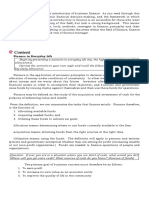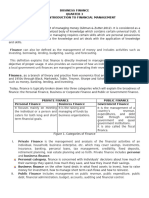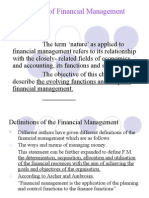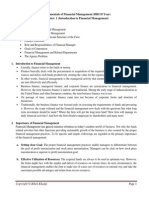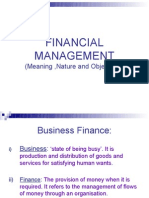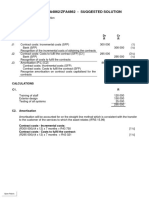0 ratings0% found this document useful (0 votes)
3 viewsUnit 1 First
The document discusses the importance of earnings and cash flow analysis, emphasizing free cash flow and financial ratios. It defines finance as both a resource and a discipline, detailing its various classifications, functions, and goals, including profit and wealth maximization. Additionally, it addresses the agency problem, highlighting conflicts of interest between shareholders and managers, as well as shareholders and creditors, and suggests remedial measures to mitigate these issues.
Uploaded by
bhojCopyright
© © All Rights Reserved
Available Formats
Download as PPT, PDF, TXT or read online on Scribd
0 ratings0% found this document useful (0 votes)
3 viewsUnit 1 First
The document discusses the importance of earnings and cash flow analysis, emphasizing free cash flow and financial ratios. It defines finance as both a resource and a discipline, detailing its various classifications, functions, and goals, including profit and wealth maximization. Additionally, it addresses the agency problem, highlighting conflicts of interest between shareholders and managers, as well as shareholders and creditors, and suggests remedial measures to mitigate these issues.
Uploaded by
bhojCopyright
© © All Rights Reserved
Available Formats
Download as PPT, PDF, TXT or read online on Scribd
You are on page 1/ 15
Unit 1: Earnings and Cash Flow Analysis
Inadequacy of accounting numbers
Emphasis on free cash flow
Interpretation of financial ratios
Meaning and Scope of Finance
Finance in general sense is viewed as money or
wealth.
In the modern world, it is viewed as a resource as
well as a discipline, a subject of study.
When the finance is defined as a resource, it is
simply a monetary means which is used to acquire
the assets by an entity.
The finance as a discipline, a subject of study, deals
with various decisions regarding how an individual
entity such as individual, business, or government
manages (surplus or deficit) of the funds.
Meaning and Scope of Finance continue . . .
The finance in a broad sense is the mobilization of
funds from surplus generating sectors to deficit
facing of economy.
It acquires the funds from various possible sources
and managed so as to allocate the accumulated
funds among and between individuals, businesses,
and governments.
This process is believed to accomplish the objective
of maximizing wealth through maximizing market
price per share.
Meaning and Scope of Finance continue . . .
Areas of finance (classification): public finance, personal
finance, and business finance.
Public finance is concerned with acquisition and utilization
of funds by the government units in order to promote the
public utility sectors to benefits the society and thus well
beings of people.
The personal finance refers raising and utilization of funds
by the household sectors (individuals and families) to fulfill
their needs.
The business finance is art and science that acquires,
manages, and utilizes the funds by business entity, who aims
to maximize the wealth of its shareholders. This business
finance is called by many names: corporate finance,
managerial finance, financial management, etc.
Functions of Financial Management
Decisions carried out to achieve objectives of the firm
Executive finance function
Routine finance function
Executive finance function
Carry out at top level
It requires managerial skills in their planning,
execution, and control
Consists investment decision, financing decision,
dealing with financial market, dividend decision,
working capital decision.
Functions of Financial Management continue . . .
Investment Decision
Decision regarding acceptance or rejection of long-
term investment projects (capital budgeting
decision)
Financing Decision
Concerned with acquisition of funds from most
appropriate sources.
Dealing with Financial Markets
Dealing/negotiating with suppliers of funds: banks
and other institutions
Dividend Decision
Decision regarding the allocation of net income into
dividend and retained earnings.
Working Capital Decision
Decision regarding the investment in current assets.
Routine Finance Function
These are daily clerical finance function that do not require
specialized skills of finance. Some of the routine finance
functions are as follows:
Supervision of cash receipts and disbursements
Safeguarding of cash balances
Record keeping of the financial performance of the firm
Reporting to the top management
Supervision of fixed assets and current assets, etc.
Goals of Financial Management
The goal is the purpose that a firm aims to achieve.
Profit maximization
Wealth maximization
Profit Maximization Goal
It gives more emphasis to increase profits and the projects that
decrease profits are avoided.
This goal believes that only the profit maximization goal can
increase the economic efficiency of individual firms.
However, many people have criticized this goal on following
grounds.
1. Ambiguity
Profit is a vague term. It conveys different meanings to
different people.
For example, the term profit may mean long-term profit or
short-term profit, profit after tax or profit before tax, gross
profit or net profit, earning per share, return on equity, etc.
Goals of Financial Management continue . . .
2. Ignores the Time Value of Money Benefits
Benefits received in earlier periods are more valuable than the
benefits received in the future period. This concept does not
considered in this profit maximization goal.
Year Future Cash Flows
Project A Project B
1 Rs 5,000 Rs 0
2 10,000 15,000
3 20,000 20,000
Total Rs 35,000 Rs 35,000
Both have total return of Rs 35,000 and profit
maximization goal treats these two projects equally.
However, in reality Project is superior over Project B.
Goals of Financial Management continue . . .
2. Ignores Quality of Benefits
Quality of benefits refers to the degree of certainty with which the
future benefits can be expected from the financial course of
action. Greater the uncertainty of expected benefits, lower the
quality of benefits.
Expected Cash Inflows
State of Economy Probability
Project A Project B
Weak 50% Rs 20,000 Rs 0
Strong 50% Rs 20,000 Rs 40,000
Both the project will be same which is Rs 20,000 [{Rs 20,000 x 0.5 +
Rs 20,000 x 0.5} or {Rs 0 x 0.5 + Rs 40,000 x 0.5}]. However, level of
risk is higher for Project B. Profit maximization treats both
projects same, but in reality Project A is to be selected.
Goals of Financial Management continue . . .
3. Not Suitable for Modern Business
Profit maximization objective was developed in the 19th century when the
majority of business was self-financing. The modern business is
characterized with separate ownership and management. The owners and
managers have their own rights and responsibilities. The owners or
investors, therefore, cannot impose profit maximization goal on the
companies.
Maximizing profits goal is considered outdated, unethical, unrealistic,
difficult and unsuitable in today’s context. It increased conflict of interest
among a number of stakeholders such as customers, employees,
government, society etc. It might lead to inequality of income and wealth.
So it is doubtful that it leads to optimum social welfare as advocated.
Goals of Financial Management continue . . .
Shareholders’ Wealth Maximization Goal
Due to the several problems associated with profit maximization, the goal of
financial management has been recognized as maximization of the current value per
share of the existing stock, known as shareholders’ wealth maximization.
A decision that has a positive net present value creates wealth for shareholders and
a decision that has a negative net present value destroys wealth of shareholders.
Stock price maximization is considered superior goal to profit maximization goal due
to following reasons:
1. Shareholders wealth maximization goal is clear
2. It considers the timing of cash flows
3. It considers quality of benefits
4. It reduces the conflict of interest among the stakeholders of a firm
Agency Problem
Agency problem is the conflict of interest between the principal and agent. In the financial
management agency problem refers to the potential conflict of interest between.
- Stockholders and Managers
- Stockholders and Creditors
Stockholders and Managers
Problem, here, refers to the divergence of interest between owner and the manager. Some
of the examples of how this problem can manifest itself include:
Managers are willing to increase their salaries and perquisites, rather than increase
shareholders dividends.
Managers are interested in maximizing the size of firms so that any hostile takeover
(unfriendly control) is less likely and also it increases their power, status and salaries.
Agency Problem continue . . .
Managers might use corporate funds to contribute to their favorite charitable
institutions or political parties for their glory and personal satisfaction.
Shareholders are willing to undertake new project and managers are not willing to
take new risky project.
Remedial Measures
Management compensation (Basic salary, bonus, executive stock option,
performance shares)
Direct intervention by shareholders (forcing to change management)
Threat of firing
Threat of takeover
Shareholders and Creditors
The conflict of interest between them arises when the managers (on behalf of company)
make decisions for shareholders value maximization by ignoring the interest of the
creditors.
The creditors are viewed as principal and the shareholders are viewed as the agent.
Shareholders and Creditors continue . . .
Shareholders have residual claim on the income as well as earnings of the firm.
Creditors make investment their capital to earn fixed rate of interest and to get
the principal paid back upon maturity. On the other hand, shareholders invest
their capital to maximize the market price of their shares.
Creditors oppose the high risk because they are not entitled to get the extra
return from additional risk.
Remedial Measures
Compensate creditors for increased risk
Protective terms and conditions for creditors
(Such as restrictions on dividend, restructuring capital structure, etc.)
You might also like
- Hourglass Workout Program by Luisagiuliet 276% (21)Hourglass Workout Program by Luisagiuliet 251 pages
- The Hold Me Tight Workbook - Dr. Sue Johnson100% (16)The Hold Me Tight Workbook - Dr. Sue Johnson187 pages
- Read People Like A Book by Patrick King-Edited62% (66)Read People Like A Book by Patrick King-Edited12 pages
- Livingood, Blake - Livingood Daily Your 21-Day Guide To Experience Real Health77% (13)Livingood, Blake - Livingood Daily Your 21-Day Guide To Experience Real Health260 pages
- COSMIC CONSCIOUSNESS OF HUMANITY - PROBLEMS OF NEW COSMOGONY (V.P.Kaznacheev,. Л. V. Trofimov.)94% (212)COSMIC CONSCIOUSNESS OF HUMANITY - PROBLEMS OF NEW COSMOGONY (V.P.Kaznacheev,. Л. V. Trofimov.)212 pages
- Donald Trump & Jeffrey Epstein Rape Lawsuit and Affidavits83% (1016)Donald Trump & Jeffrey Epstein Rape Lawsuit and Affidavits13 pages
- The 36 Questions That Lead To Love - The New York Times94% (34)The 36 Questions That Lead To Love - The New York Times3 pages
- The 36 Questions That Lead To Love - The New York Times95% (21)The 36 Questions That Lead To Love - The New York Times3 pages
- Jeffrey Epstein39s Little Black Book Unredacted PDF75% (12)Jeffrey Epstein39s Little Black Book Unredacted PDF95 pages
- The 4 Hour Workweek, Expanded and Updated by Timothy Ferriss - Excerpt23% (954)The 4 Hour Workweek, Expanded and Updated by Timothy Ferriss - Excerpt38 pages
- Chapter 1 - Overview of Financial ManagementNo ratings yetChapter 1 - Overview of Financial Management4 pages
- Chapter 1 Introduction To Financial ManagementNo ratings yetChapter 1 Introduction To Financial Management5 pages
- Introduction to Financial Management LESSON 01No ratings yetIntroduction to Financial Management LESSON 0144 pages
- Dire-Dawa University Institute of Technology: Construction Technology and Management Chair Course Code: byNo ratings yetDire-Dawa University Institute of Technology: Construction Technology and Management Chair Course Code: by34 pages
- Introduction To Basic Elements of Financial ManagementNo ratings yetIntroduction To Basic Elements of Financial Management27 pages
- Chapter 01-The Role and Environment of Managerial FinanceNo ratings yetChapter 01-The Role and Environment of Managerial Finance24 pages
- Chapter 1 Introduction - Chapter 2 Industrial ProfileNo ratings yetChapter 1 Introduction - Chapter 2 Industrial Profile74 pages
- Unit 1. Basic Concepts in Finance: Principles of Finance by Prof. Swati BhaleraoNo ratings yetUnit 1. Basic Concepts in Finance: Principles of Finance by Prof. Swati Bhalerao104 pages
- UNIT 1 Introduction to Financial Management (2) (1)No ratings yetUNIT 1 Introduction to Financial Management (2) (1)14 pages
- Financial Management Economics For Finance 1711104949No ratings yetFinancial Management Economics For Finance 1711104949111 pages
- Chapter 1 Scope and Objectives of Financial Management 2No ratings yetChapter 1 Scope and Objectives of Financial Management 219 pages
- Fundamentals of Financial Management (BBS II Year) Chapter: 1 (Introduction To Financial Management)No ratings yetFundamentals of Financial Management (BBS II Year) Chapter: 1 (Introduction To Financial Management)7 pages
- Chap 1. Financial Management 1.1 Finance and Related DisciplineNo ratings yetChap 1. Financial Management 1.1 Finance and Related Discipline13 pages
- Chapter 1: Overview: Classification of FinanceNo ratings yetChapter 1: Overview: Classification of Finance8 pages
- Chapter 1: Overview: Classification of FinanceNo ratings yetChapter 1: Overview: Classification of Finance8 pages
- According To Phillipatus, "Financial Management Is Concerned With The Managerial Decisions ThatNo ratings yetAccording To Phillipatus, "Financial Management Is Concerned With The Managerial Decisions That26 pages
- Financial Management: (Meaning, Nature and Objectives)No ratings yetFinancial Management: (Meaning, Nature and Objectives)23 pages
- Financial Literacy for Entrepreneurs: Understanding the Numbers Behind Your BusinessFrom EverandFinancial Literacy for Entrepreneurs: Understanding the Numbers Behind Your BusinessNo ratings yet
- Secrets of Financial Success: A Practical Guide to Achieving Financial Freedom in an Era of Economic ChangeFrom EverandSecrets of Financial Success: A Practical Guide to Achieving Financial Freedom in an Era of Economic ChangeNo ratings yet
- Lecture 1 Undrstading Financial AccountingNo ratings yetLecture 1 Undrstading Financial Accounting32 pages
- Notes: Right of Pre-Emption of StockholdersNo ratings yetNotes: Right of Pre-Emption of Stockholders17 pages
- Homework - Closing Case Chapter 2: Economic Transformation in VietnamNo ratings yetHomework - Closing Case Chapter 2: Economic Transformation in Vietnam3 pages
- Presented Below Are The Income Statement of AMFITA CorpNo ratings yetPresented Below Are The Income Statement of AMFITA Corp9 pages
- Data Interpretation Replica Questions That Have Appeared in in The Last 4 Years100% (1)Data Interpretation Replica Questions That Have Appeared in in The Last 4 Years38 pages
- Derivatives As Hedging Instrument in Managing Foreign Currency ExposuresNo ratings yetDerivatives As Hedging Instrument in Managing Foreign Currency Exposures52 pages
- Chapter 6 - Accounting and The Time Value of Money100% (2)Chapter 6 - Accounting and The Time Value of Money96 pages
- United States Bankruptcy Court Southern District of Florida Voluntary Petition100% (1)United States Bankruptcy Court Southern District of Florida Voluntary Petition55 pages
- Women As Emerging Entrepreneurs in IndiaNo ratings yetWomen As Emerging Entrepreneurs in India15 pages
- Livingood, Blake - Livingood Daily Your 21-Day Guide To Experience Real HealthLivingood, Blake - Livingood Daily Your 21-Day Guide To Experience Real Health
- COSMIC CONSCIOUSNESS OF HUMANITY - PROBLEMS OF NEW COSMOGONY (V.P.Kaznacheev,. Л. V. Trofimov.)COSMIC CONSCIOUSNESS OF HUMANITY - PROBLEMS OF NEW COSMOGONY (V.P.Kaznacheev,. Л. V. Trofimov.)
- Donald Trump & Jeffrey Epstein Rape Lawsuit and AffidavitsDonald Trump & Jeffrey Epstein Rape Lawsuit and Affidavits
- The 36 Questions That Lead To Love - The New York TimesThe 36 Questions That Lead To Love - The New York Times
- The 36 Questions That Lead To Love - The New York TimesThe 36 Questions That Lead To Love - The New York Times
- Jeffrey Epstein39s Little Black Book Unredacted PDFJeffrey Epstein39s Little Black Book Unredacted PDF
- The 4 Hour Workweek, Expanded and Updated by Timothy Ferriss - ExcerptThe 4 Hour Workweek, Expanded and Updated by Timothy Ferriss - Excerpt
- Dire-Dawa University Institute of Technology: Construction Technology and Management Chair Course Code: byDire-Dawa University Institute of Technology: Construction Technology and Management Chair Course Code: by
- Introduction To Basic Elements of Financial ManagementIntroduction To Basic Elements of Financial Management
- Chapter 01-The Role and Environment of Managerial FinanceChapter 01-The Role and Environment of Managerial Finance
- Chapter 1 Introduction - Chapter 2 Industrial ProfileChapter 1 Introduction - Chapter 2 Industrial Profile
- Unit 1. Basic Concepts in Finance: Principles of Finance by Prof. Swati BhaleraoUnit 1. Basic Concepts in Finance: Principles of Finance by Prof. Swati Bhalerao
- UNIT 1 Introduction to Financial Management (2) (1)UNIT 1 Introduction to Financial Management (2) (1)
- Financial Management Economics For Finance 1711104949Financial Management Economics For Finance 1711104949
- Chapter 1 Scope and Objectives of Financial Management 2Chapter 1 Scope and Objectives of Financial Management 2
- Fundamentals of Financial Management (BBS II Year) Chapter: 1 (Introduction To Financial Management)Fundamentals of Financial Management (BBS II Year) Chapter: 1 (Introduction To Financial Management)
- Chap 1. Financial Management 1.1 Finance and Related DisciplineChap 1. Financial Management 1.1 Finance and Related Discipline
- According To Phillipatus, "Financial Management Is Concerned With The Managerial Decisions ThatAccording To Phillipatus, "Financial Management Is Concerned With The Managerial Decisions That
- Financial Management: (Meaning, Nature and Objectives)Financial Management: (Meaning, Nature and Objectives)
- Financial Literacy for Entrepreneurs: Understanding the Numbers Behind Your BusinessFrom EverandFinancial Literacy for Entrepreneurs: Understanding the Numbers Behind Your Business
- Financial Strategies for Business ExcellenceFrom EverandFinancial Strategies for Business Excellence
- Secrets of Financial Success: A Practical Guide to Achieving Financial Freedom in an Era of Economic ChangeFrom EverandSecrets of Financial Success: A Practical Guide to Achieving Financial Freedom in an Era of Economic Change
- Homework - Closing Case Chapter 2: Economic Transformation in VietnamHomework - Closing Case Chapter 2: Economic Transformation in Vietnam
- Presented Below Are The Income Statement of AMFITA CorpPresented Below Are The Income Statement of AMFITA Corp
- Data Interpretation Replica Questions That Have Appeared in in The Last 4 YearsData Interpretation Replica Questions That Have Appeared in in The Last 4 Years
- Derivatives As Hedging Instrument in Managing Foreign Currency ExposuresDerivatives As Hedging Instrument in Managing Foreign Currency Exposures
- Chapter 6 - Accounting and The Time Value of MoneyChapter 6 - Accounting and The Time Value of Money
- United States Bankruptcy Court Southern District of Florida Voluntary PetitionUnited States Bankruptcy Court Southern District of Florida Voluntary Petition











































